
Section 4: Operation
Tilling Tips & Techniques
Let the tiller do the work
•While tilling, relax and let the wheels pull the tiller along while the tines do the digging. Walk on the side that is not yet finished (to avoid making foot- prints in the freshly tilled soil) and lightly, but securely grip the handlebar with just one hand.
•Avoid pushing down on the handlebars in an attempt to force the tiller to dig deeper. Doing so takes the weight off the powered wheels, causing them to lose traction. Without the wheels helping to hold the tiller back, the tines will attempt to propel the tiller – often causing the tiller to skip rapidly across the ground. (Sometimes, slight down- ward pressure on the handlebars will help get through a particularly tough section of sod or unbroken ground, but in most cases this won’t be necessary at all.)
Tilling depths
•Avoid trying to dig too deeply too quickly, especially when busting sod or when tilling soil that hasn’t been tilled for some time. Use shallow depth reg- ulator settings (only an inch or two deep) for the first passes through the garden area. With each succeeding pass, adjust the depth regulator to dig another inch or two deeper. (Watering the garden area a few days prior to tilling will make tilling easier, as will letting the newly worked soil set for a day or two before making a final, deep tilling pass.)
•When cultivating (breaking up the surface soil around plants to help destroy weeds), use very shallow depth settings to prevent injury to plants whose roots often grow close to the surface. If needed, lift up on the handlebars slightly to prevent the tines from digging too deeply. (Cultivating on a regular basis not only eliminates weeds, it also loosens and aerates the soil for better moisture absorption and faster plant growth.)
Avoid tilling soggy, wet soil
Tilling wet soil often results in large, hard clumps of soil that can interfere with planting. If time permits, wait a day or two after heavy rains to allow the soil to dry before tilling. Test soil by squeez- ing it into a ball. If it compresses too easily, it is too wet to till.
Avoid making footprints
When possible, walk on the untilled side of the unit to avoid making footprints in the freshly tilled soil. Footprints cause soil compaction that can hamper root penetration and contribute to soil erosion. They can also “plant” unwanted weed seeds back into the freshly tilled ground.
Choosing correct wheel and tine speeds
With experience, you will find the “just right” tilling depth and tilling speed com- bination that is best for your garden.
Set the Engine Throttle Control Lever to a speed to give the engine adequate power and yet allow it to operate at the slowest possible speed...at least until you have achieved the maximum tilling depth you desire. Faster engine speeds may be desirable when making final passes through the seedbed or when cultivating. Selection of the correct engine speed, in relation to the tilling depth, will ensure a sufficient power level to do the job without causing the engine to labor.
Suggested tilling patterns
•When preparing a seedbed, go over the same path twice in the first row, then overlap
•If the garden size will not permit lengthwise and then crosswise tilling, then overlap the first passes by one- half a tiller width, followed by succes- sive passes at
•With planning, you can allow enough room between rows to cultivate (see Figure
Figure
Figure
1
![]()
![]()
![]()
![]()
![]()
![]()
![]()
![]() 2 3
2 3 ![]()
![]()
![]()
![]()
Figure
Figure
19
